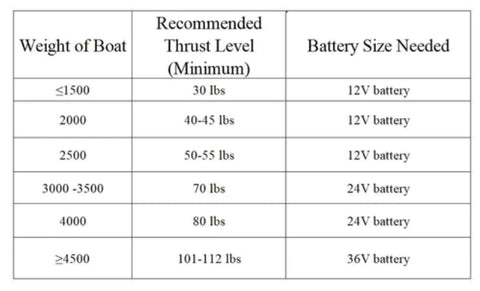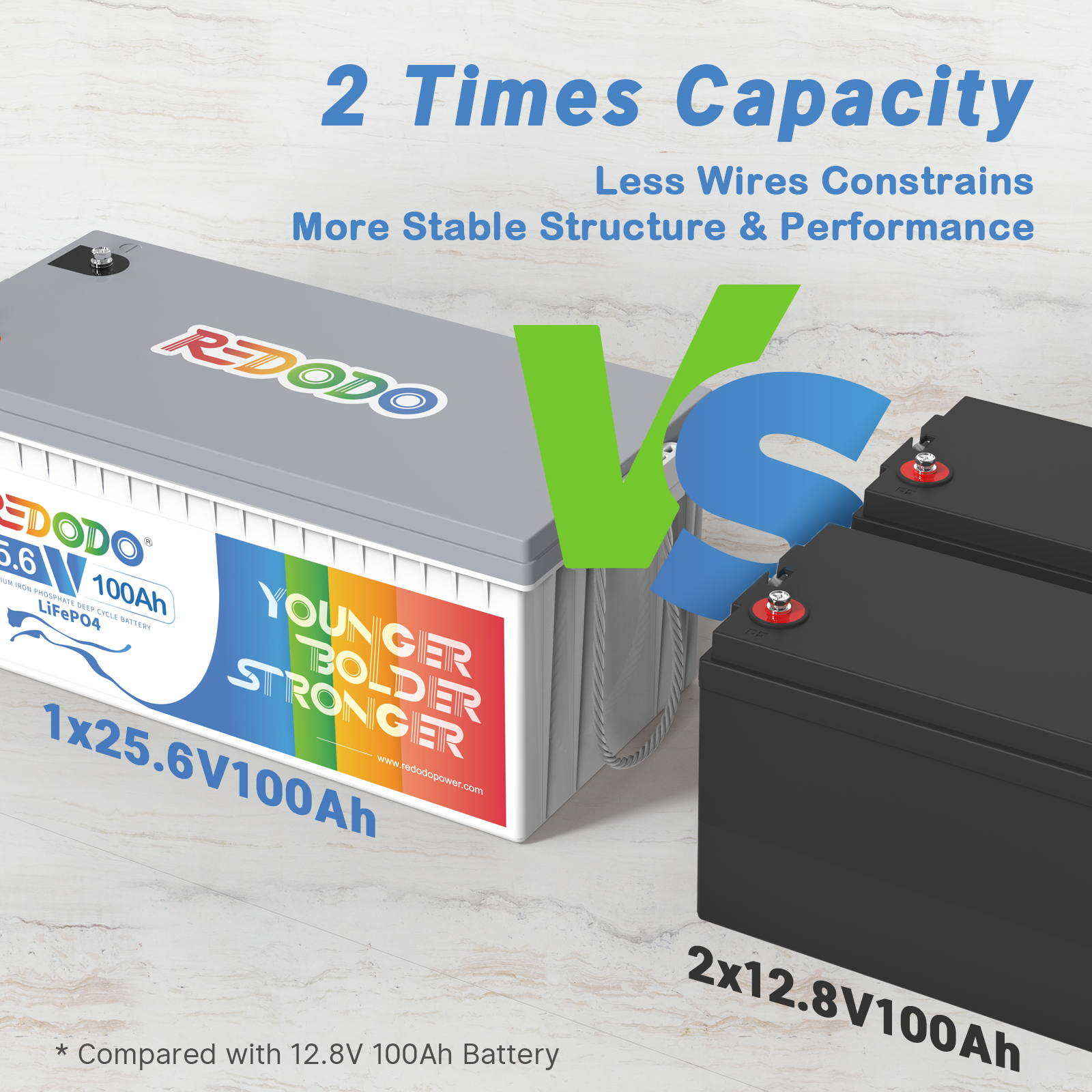[Full Guide] Trolling Motor Battery System: 12V 24V 36V?
As an avid angler, investing in the right trolling motor battery system can make or break your fishing experience. When it comes to voltage, the decision between 12V, 24V, and 36V can seem daunting. In this article, we'll delve into the intricacies of each system to help you make an informed decision.
Understanding the Role of Voltage in Trolling Motors
The voltage of a trolling motor determines its power output and performance capabilities. Voltage refers to the electrical pressure that causes current to flow through the motor. Higher voltage motors typically provide more thrust, faster speeds, and greater efficiency when powered by a battery.
Properly matching the trolling motor voltage to the size, weight and intended use of your boat is essential for optimal functionality. Larger or heavier vessels tend to require higher voltages for sufficient thrust to maneuver and maintain headway against wind or current resistance.

The three primary voltage options for trolling motors are 12V, 24V, and 36V systems. Twelve-volt motors generally suit smaller aluminum boats weighing under 1,000 pounds used for activities like panfish fishing. Twenty-four volt motors perform well on jon boats and light bass boats up to 1,500 pounds. Thirty-six volt motors generate the highest power output, best suited to heavy fiberglass bass or multi-person fishing boats over 1,800 pounds.
Higher voltage motors access greater battery capacity for extended runtime before recharging is needed. They can also thrust heavier loads at faster speeds while drawing less current than lower voltage equivalents. Carefully considering boat size, load capacity and intended activities helps determine the optimal trolling motor voltage. Proper voltage selection unlocks peak power and control on the water.
12V Trolling Motor Battery System
A 12V trolling motor battery system is the most common and versatile option. It is ideal for smaller boats and casual anglers. With its lightweight and compact design, it's easy to maneuver and suitable for short fishing trips in calm waters. However, its power output may not be sufficient for larger boats or extended usage.
The Redodo 12.8V 100Ah LiFePO4 battery is a high-performance lithium-ion power pack well-suited for trolling motor applications. Using lithium iron phosphate (LiFePO4) chemistry, it offers strong performance even in cold temperatures down to -4°F.

At 12.8 volts and 100Ah capacity, this battery provides ample power in a compact and lightweight package for most freshwater fishing boats. Its integrated battery management system (BMS) carefully regulates charging and discharging to maximize battery health and safety.

Additional key features include short circuit, overcharge, and over-discharge protection. Low self-discharge rates of only 3% per month ensure long shelf life whether in use or storage. Cycle life is rated at over 4,000 times, far surpassing lead-acid batteries.
Sustainable and eco-friendly, the Redodo LiFePO4 battery delivers reliable cranking and running power season after season. Its durability and safety make it a top pick for motorized anglers in cold weather regions.
24V Trolling Motor Battery System
Stepping up to a 24V trolling motor battery system increases the power and thrust output, making it suitable for medium-sized aluminum fishing boats in the 14-16 foot range. With its higher voltage, a 24V system will provide noticeably quicker acceleration and top speeds compared to a 12V setup.

The additional power headroom allows for pulling slightly heavier loads with ease, such as carrying multiple passengers or fishing with downriggers deployed. It provides a balance between performance and runtime, allowing anglers to troll efficiently for half day trips or longer without recharging.
A typical 24V lithium battery configuration would involve two 12V 100Ah batteries wired in series, providing a total capacity of 100Ah at 24 volts. This dual battery bank optimizes both power and energy capacity for improved control and thrust during the livelier seasons when trolling multiple structures in a single outing.
With its ability to smoothly maneuver medium-sized boats while spot-locking or crawling weedslines, a 24V system has become the voltage of choice for serious freshwater anglers. It delivers the step up in capabilities needed to maximize time on the water.
36V Trolling Motor Battery System
The extra power from a 36V system allows heavier boats in the 16-18 foot range with extra fishing gear and passengers to be piloted with greater ease and control. The higher voltage translates to more robust torque even under load.
Longer runtimes between charges are possible thanks to the 36V system's very low current draw. It utilizes the battery's full capacity more efficiently through precise BMS regulation. Runtimes can stretch from all-day trips into multi-day excursions.
The higher voltage also means faster trolling speeds and stronger holding power in surging waves or swells. Anglers gain the battery muscle needed to dominate more challenging inland and coastal fisheries with heavy currents or wind.
Additional thrust lets 36V motors shoulder tasks like bow-mounting downriggers without significant speed loss. Its reserves are very handy when navigating crowded tournaments or unfamiliar heavy-traffic areas safely.
Overall, a 36V system unlocks a new level of commanding control and smooth power ideally suited for serious anglers fishing from larger multi-purpose boats.
How Voltage Impacts Trolling Motor Runtime
A key factor influencing trolling motor runtime is voltage selection. Higher voltage motors tend to operate more efficiently, drawing less current from the battery for the same level of thrust.
Lower current draw means less strain on the battery, preserving its charge capacity longer. For example, a 24V motor uses battery power more efficiently than a comparable 12V motor.
Voltages like 12V, 24V, and 36V are common options. Larger voltage motors access more of the battery's potential energy storage, resulting in extended periods of use before recharging is required.
Other runtime affects include battery health, load weight, and operating conditions. Running at higher boat speeds or in choppy water increases draw faster over time.
Selecting the right voltage for your boat's size, coupled with a high-quality battery appropriately matched to that voltage, maximizes efficiency. Following battery maintenance best practices and operating conservatively by minimizing high-speed maneuvers further extends runtimes.
Careful consideration of all voltage and battery factors allows anglers to benefit from longer continuous trolling before needing to return to shore or the dock to recharge. This enhances any fishing trip experiences out on the water all day long.
Factors to Consider When Choosing Voltage
When deciding on the right trolling motor battery system, several factors come into play. Boat size, weight, and usage frequency are essential considerations. Understanding how these factors influence the battery's voltage will help you make an informed decision based on your specific needs.
Boat Size and Weight
Larger, heavier boats require higher voltages to achieve sufficient thrust for maneuverability. As a general guide, 12V is suitable for boats under 1000 lbs, 24V for boats 1000-1500 lbs, and 36V for boats over 1500 lbs.
Battery Cost and Maintenance
Higher voltage batteries tend to be more expensive than lower voltage options but may offer better value through longer lifespans with less maintenance over time.
Motor Load and Terrain
Boats that must navigate rougher water or high wind conditions, or carry additional fishing gear/passengers benefit from a higher voltage motor.
Motor Features and Power Needs
Consider gear speeds, thrust, and onboard accessory power demands to ensure the voltage supports functional needs over the boat's lifespan.
Budget
Voltage upgrades usually involve new batteries, which impact upfront costs. Weigh initial investments versus longterm performance and runtime requirements.
Motor and Controller Compatibility
Ensure electronics like the battery, regulator, motor, and switch panel are matched for reliable high or low voltage circuits.
By thoroughly evaluating these key decision factors aligned with your boating needs, you can feel confident selecting the optimal trolling motor voltage for safe, enjoyable outings.
Tow 12V Batteries in Series or One 24V Battery?
There are pros and cons to consider when deciding whether to use two 12V batteries in series to create a 24V system, or a single 24V battery for your trolling motor setup:
Using two 12V batteries in series allows you to take advantage of the higher voltage output of a 24V system. This provides more power and thrust from your trolling motor. It also allows you to add battery capacity more easily by adding extra 12V batteries.
However, connecting 12V batteries in series requires careful wiring to balance the charge and prevent overcharging one battery. It also adds complexity that could lead to connection issues over time.
A single 24V marine battery is simpler to install and maintain. But it has a fixed capacity that can only be upgraded by replacing the whole battery.
Other factors include cost, weight/space needs, and required charging setup. Over time, two smaller 12V batteries may need replacement more often than a big 24V battery.
Related reading: Can I Charge LiFePO4 Battery with a Normal Charger?
Overall, a single 24V battery is likely the easiest option if it provides sufficient capacity for your needs. Using two 12V batteries in series works well for extra runtime but requires more monitoring and maintenance skills. Consider your boating needs and preferences to choose the best setup.
FAQs about Trolling Motor Battery System
1. Can I use a higher voltage battery system than recommended for my trolling motor?
It's generally not recommended as it may cause the motor to overheat or shorten its lifespan. Stick to the voltage rating specified by the motor manufacturer.
2. Do different voltage systems require specific chargers?
Yes, chargers are matched to the battery voltage and a 12V charger can't be used on a 24V battery, for example. Use a charger labeled for the voltage system.
3. How do I determine the right voltage for my boat's trolling motor?
Consider the boat size/weight, horsepower of main motor, terrain, load capacity, and manufacturer recommendations. 12V for small boats, 24V for medium, 36V for large multi-person boats.
4. What are the common signs of a failing trolling motor battery?
Loss of runtime, inability to reach top speeds, sluggish performance, cracked or bulging case, warm to hot during use are all red flags a battery needs replacing.
5. Can I switch between different voltage systems on the same boat?
It's difficult and expensive to switch between 12V/24V/36V systems as it requires all new wiring and components. Best to choose the right voltage up front based on your needs.
Conclusion
Choosing the right trolling motor battery system is a critical decision for any angler. Understanding the nuances of 12V, 24V, and 36V systems is essential in optimizing your fishing experience. By evaluating your specific needs and considering the factors at play, you can confidently select the ideal voltage system for your boat and fishing preferences.
![[Full Guide] Trolling Motor Battery System: 12V 24V 36V?](http://www.redodopower.com/cdn/shop/files/20220402-182128_f406e536-af3b-484f-ba7c-2f4771ec4559.png?crop=center&format=webp&height=24&v=1656668006&width=24)
Redodo
![[Full Guide] Trolling Motor Battery System: 12V 24V 36V?](http://www.redodopower.com/cdn/shop/files/20220402-182128_f406e536-af3b-484f-ba7c-2f4771ec4559.png?crop=center&format=webp&height=24&v=1656668006&width=24)
Redodo
Join Redodo
Related Post

How to Store a Deep Cycle Marine Battery for Winter?

What Size Solar Panel Do I Need to Charge A 12V Battery?

Light Up Your Christmas with Redodo: LiFePO4 Batteries Holiday Deals

How to Choose the Best Battery for Van Life?









